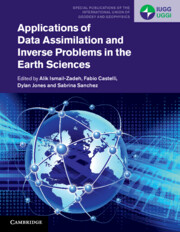Book contents
- Applications of Data Assimilation and Inverse Problems in the Earth Sciences
- Series page
- Applications of Data Assimilation and Inverse Problems in the Earth Sciences
- Copyright page
- Contents
- Contributors
- Preface
- Acknowledgements
- Part I Introduction
- 1 Inverse Problems and Data Assimilation in Earth Sciences
- 2 Emerging Directions in Geophysical Inversion
- 3 A Tutorial on Bayesian Data Assimilation
- 4 Third-Order Sensitivity Analysis, Uncertainty Quantification, Data Assimilation, Forward and Inverse Predictive Modelling for Large-Scale Systems
- Part II ‘Fluid’ Earth Applications: From the Surface to the Space
- Part III ‘Solid’ Earth Applications: From the Surface to the Core
- Index
- References
3 - A Tutorial on Bayesian Data Assimilation
from Part I - Introduction
Published online by Cambridge University Press: 20 June 2023
- Applications of Data Assimilation and Inverse Problems in the Earth Sciences
- Series page
- Applications of Data Assimilation and Inverse Problems in the Earth Sciences
- Copyright page
- Contents
- Contributors
- Preface
- Acknowledgements
- Part I Introduction
- 1 Inverse Problems and Data Assimilation in Earth Sciences
- 2 Emerging Directions in Geophysical Inversion
- 3 A Tutorial on Bayesian Data Assimilation
- 4 Third-Order Sensitivity Analysis, Uncertainty Quantification, Data Assimilation, Forward and Inverse Predictive Modelling for Large-Scale Systems
- Part II ‘Fluid’ Earth Applications: From the Surface to the Space
- Part III ‘Solid’ Earth Applications: From the Surface to the Core
- Index
- References
Summary
Abstract: This chapter provides a broad introduction to Bayesian data assimilation that will be useful to practitioners in interpreting algorithms and results, and for theoretical studies developing novel schemes with an understanding of the rich history of geophysical data assimilation and its current directions. The simple case of data assimilation in a ‘perfect’ model is primarily discussed for pedagogical purposes. Some mathematical results are derived at a high level in order to illustrate key ideas about different estimators. However, the focus of this chapter is on the intuition behind these methods, where more formal and detailed treatments of the data assimilation problem can be found in the various references. In surveying a variety of widely used data assimilation schemes, the key message of this chapter is how the Bayesian analysis provides a consistent framework for the estimation problem and how this allows one to formulate its solution in a variety of ways to exploit the operational challenges in the geosciences.
Keywords
- Type
- Chapter
- Information
- Publisher: Cambridge University PressPrint publication year: 2023



